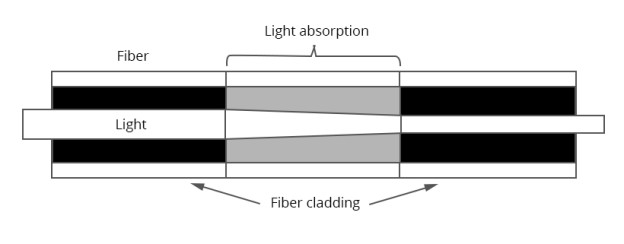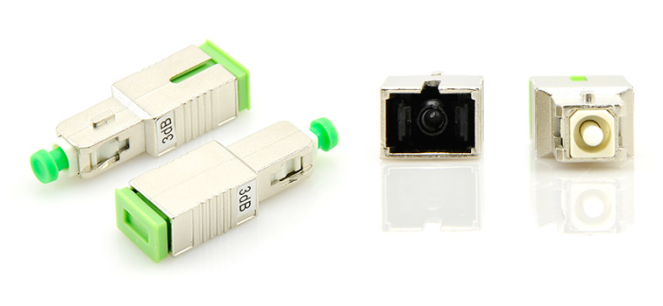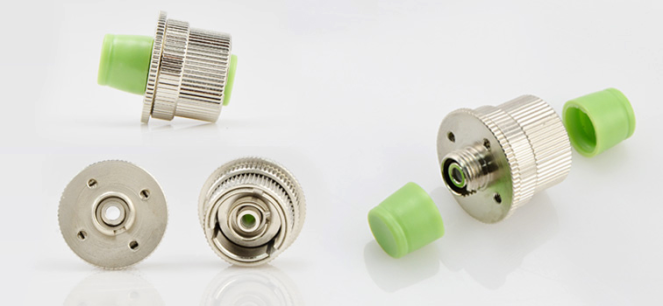The fiber optic attenuator is also referred to as optical attenuator, which is generally used in single-mode long-haul application. Meanwhile, it is also known as transmission loss attenuation. From its name, it is easy to know that the function of optical attenuator is optical signal attenuation. That’s to say, the fiber optic attenuator is designed to decrease the level of signal power when the optical signal is propagated along a free space or a fiber optic cable.
When we talk about optical power in light transmission, we always think the stronger the power is, the better the transmission performance will be. Then, why the fiber optic attenuator is developed? Why we should attenuate the optical power? Will the fiber optic attenuator have a negative effect on optical signal transmission?
As we know, in the single-mode fiber optic cable, the light source is laser which is really strong, so that the light signal can be transmitted as long as possible. However, if the transmission distance is not so long, too much optical power will overload the fiber optic receiver. Furthermore, if there is a mismatch between the transmitter/receiver that the optical power sent from the transmitter is too strong, the receiver must meet the optical overload. In this case, the fiber optic attenuator is developed and should be inserted in the receiver side to reduce the optical power into a bearable load, then optical overload can be avoided.
In general, the fiber optic attenuator is a passive optical device which can decrease the level of signal power according to its design. It is commonly used for adjusting or testing the power of the light signal in optical communication to ensure the good working condition of the optical system.
With the rapid development of optical technology, the optical signal attenuation can be dealt with by many methods, for instance, gap-loss, reflection, absorption, diffusion, scattering, deflection, diffraction, and dispersion, etc.
The most popular method used by the fiber optic attenuator is the absorptive principle, which is very simple by setting a material like sunglass to absorb the extra light power and convert it to heat. The fiber optic attenuator running with absorptive principle has a working wavelength range, in which it can absorb all light power equally. What’s the most important is its superiority that it will not reflect or scatter the light into an air gap, which may not cause the unwanted back reflection in the fiber communication system.

As for the fiber optic attenuator working with reflective principle, the major power loss in optical fiber is caused by the reflection. One of its advantage is to reflect a known quantity of the light signal, thus only allowing the desired portion of the signal to be propagated in the fiber communication system.
In short, there are many types of fiber optic attenuators operating with various principles, which are developed to use in different occasions. You can just choose the one suitable for the optic system you use.
Similarly, two kinds of fiber optic attenuators which are developed by different forms, are typically classified as fixed or variable attenuators. Both of them have unique characteristics to meet the requirements in different occasions. Here are the detailed characteristics of fixed and variable attenuators for your reference.
The fixed fiber optic attenuator, as its name implies, is designed to reduce the signal power with a set, unchanged level, which is typically used for single-mode applications. Theoretically, it can be fabricated to provide any amount of attenuation. In the signal transmission process, when the signal approaches a device or node in a fiber communication link, the power will be reduced to a level that is suitable for its application. It is designed to make signal reflection as small as possible, therefore more accurate transmissions of data can be sent.

Generally, the fixed fiber optic attenuator can be classified by the connector type and the attenuation level. The attenuation values of fixed fiber optic attenuators are typically between 1 and 30 dB. Meanwhile, fixed fiber optic attenuators are available in LC, SC, ST, FC connector. For instance, SC 3dB fixed fiber optic attenuator, can provide 3dB optical attenuation with the SC fiber optic connector.
Clearly different from the fixed fiber optic attenuator, the variable fiber optic attenuator offers a range of attenuation values with flexible adjustment, which is usually used for testing and measuring, or equalizing the optical power between different signals. In the signal transmission process, the power attenuation is done by directly blocking the beam.

At present, there are two types of variable fiber optic attenuators, the stepwise variable attenuator and the continuous variable attenuator. The stepwise variable attenuator is able to change the attenuation of the signal in known steps such as 0.1 dB, 0.5 dB, or 1 dB, which may be used for dealing with multiple optical power sources. As for the continuous variable attenuator, it is designed to quickly and precisely change the optical attenuation on demand, commonly used in uncontrolled environments where the input and/or output device needs to change continually.
The fiber optic attenuator is an important passive optical device, which can reduce the level of signal power according to the user’s requirement as expected. As present, it is largely used in optical communication with the aim of preventing the receiver from optical overload, thereby big convenience is provided for the users.
